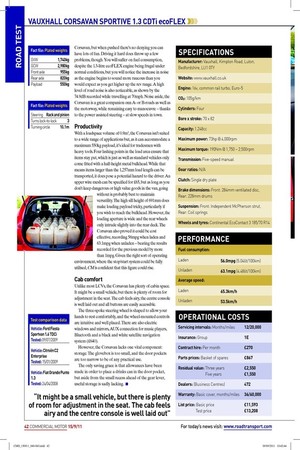1.3 CDTi ecoFLEX
Page 35

Page 36

If you've noticed an error in this article please click here to report it so we can fix it.
Think switching from a car to a car-derived van is simple? Then think again, as CM finds out how different they really are Words: George Barrow / Images: Tom Lee Their familiar appearance and ability to blend into the urban landscape means that car-derived vans (CDV) are often overlooked. Seen by some as cars with metal panels instead of windows, you could be forgiven for thinking that the process of switching car to light commercial vehicle (LCV) is a simple one – after all, modern cars all have fold-down rear seats to create a ‘van-like’ storage space. But the process requires more than simply removing the back seats. These vehicles are often among the hardest working vans in the trade, covering large amounts of motorway miles, while also having to do battle with the tight city streets. That means they must be comfortable, fuel-eficient and practical. The Corsavan lives up to these requirements, as the Corsa upon which this model is based is well-regarded since revisions were made to the dampers, springs and anti-roll bars.. There’s also a new range of engines bringing ecoFLEX turbodiesel models with stop/ start to the line-up. Newer Corsavans also look like the passenger car version, which has a new front grille, front bumper and headlights similar to those found on the Meriva. However, our test model is an earlier version that makes do with just the mechanical changes.
The new Euro-5 engine range includes two different power outputs from the same 1.3-litre diesel unit. Both the 73hp and 93hp models are available with or without the new stop/start system, while the 1.2-litre 16v Twinport engine gives buyers the option of a petrol engine producing 70hp. There is also the choice of standard or Sportive trim levels, with the latter adding several options including alloy wheels, chrome sports exhaust, and sporty seats.
On the road
When we tested the previous Corsavan in 2007, we were overwhelmed with how well it performed. Its steering, suspension and performance were suited to the nature of a vehicle like this, being agile and comfortable. Fortunately, the changes made to the Corsavan haven’t affected the appeal of this newer model. Even with maximum ballast on board, it still feels like a capable passenger car and a well-balanced LCV. The obvious problems of a crashy ride and hints of understeer that you would associate with piling over half a tonne into a vehicle with a short wheelbase have not been negated fully, but the Corsavan is an entertaining drive with great grip and balance. In daily operations you are unlikely to drive the wheels off the Corsavan, but when pushed there’s no denying you can have lots of fun. Driving it hard does throw up a few problems, though. You will suffer on fuel consumption, despite the 1.3-litre ecoFLEX engine being frugal under normal conditions, but you will notice the increase in noise as the engine begins to sound more raucous than you would expect as you get higher up the rev range. A high level of road noise is also noticeable, as shown by the 74.9dB recorded while travelling at 70mph. Noise aside, the Corsavan is a great companion onn Aor B-roads as well as the motorway, while remaining easy to manoeuvre – thanks to the power assisted steering – at slow speeds in town.
Productivity
With a loadspace volume of 0.9m3, the Corsavan isn’t suited to a wide range of applications but, as it can accommodate a maximum 550kg payload, it’s ideal for tradesmen with heavy tools. Four lashing points in the load area ensure that items stay put, which is just as well as standard vehicles only come itted with a half-height metal bulkhead. While that means items larger than the 1,257mm load length can be transported, it does pose a potential hazard to the driver. An upper wire mesh can be speciied for £65, but as long as you don’t keep dangerous or high value goods in the van, going without is probably best to maintain versatility. The high sill height of 691mm does make loading payload tricky, particularly if you wish to reach the bulkhead. However, the loading aperture is wide and the rear wheels only intrude slightly into the rear deck. The Corsavan also proved it could be cost effective, recording 56mpg when laden and 63.1mpg when unladen – beating the results recorded for the previous model by more than 1mpg. Given the right sort of operating environment, where the stop/start system could be fully utilised, CM is conident that this igure could rise.
Cab comfort
Unlike most LCVs, the Corsavan has plenty of cabin space. It might be a small vehicle, but there is plenty of room for adjustment in the seat. The cab feels airy, the centre console is well laid out and all buttons are easily accessible.
The three-spoke steering wheel is shaped to allow your hands to rest comfortably, and the wheel-mounted controls are intuitive and well placed. There are also electric windows and mirrors, AUX connection for music players, Bluetooth and a black and white satellite navigation system (£640).
However, the Corsavan lacks one vital component: storage. The glovebox is too small, and the door pockets are too narrow to be of any practical use.
The only saving grace is that allowances have been made in order to place a drinks can in the door pocket, but aside from the small recess ahead of the gear lever, useful storage is sadly lacking. ■













































